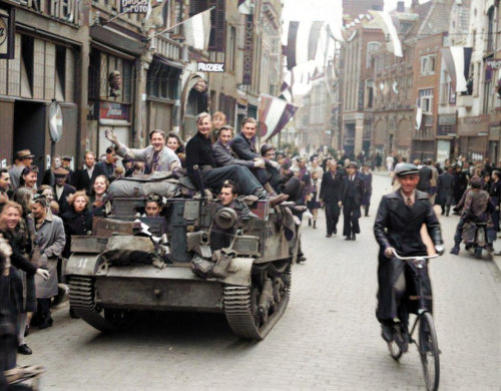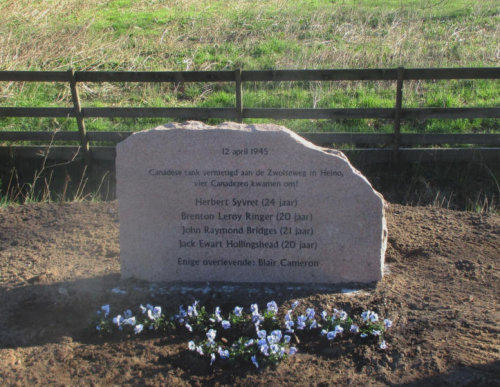
Wartime Heritage
ASSOCIATION

The Liberation of the Netherlands 1944-1945
The Netherlands was a neutral country in 1939,
invaded on May 10th, 1940, and fully occupied by May
17th. The next five years were brutal for the Dutch
people. By the winter of 1944-45, food supplies were
exhausted and thousands of men, women, and children
perished of starvation – it was a winter of hunger.
On September 4th, the Belgian city of Antwerp,
with a harbour through which supplies to the advancing
Allies could be supplied, had been liberated, but the
70-kilometre long estuary of the Scheldt River, which
connected Antwerp to the sea, was still under
occupation. The First Canadian Army was given the
task of clearing the banks of the wide, multi-channeled
River. It was a punishing place to battle - challenging
terrain of canals, dykes, flood lands, and determined
occupiers. Canadian soldiers fought a series of fierce
battles including amphibious assaults from small boats
along the estuary. Aside from the use of boats, the
movement of men, tanks and other equipment was
often restricted to narrow roadways along the top of
dykes, under frequent fire.
By November 8th the estuary and its large islands had been secured. The river was then cleared of mines, and on November 28
the first convoy of Allied cargo ships entered the port of Antwerp.
The First Canadian Army spent the winter patrolling its portion of the front line in the Netherlands skirmishing occasionally with
the enemy.
In February 1945, the Allied advance in northwest Europe resumed, with a huge offensive to drive the enemy across the Rhine
River and it fell to the First Canadian Army to clear the area pushing toward the Rhine.
In March, the Canadians were reinforced by various Allied units, including the 1st Canadian Corps, transferred north from the
battlegrounds of Italy. It was the first time in history, two Canadian army corps were fighting together. And with an international
strength now of more than 450,000 men, the First Canadians became the largest army ever commanded by a Canadian officer.
As other Allied armies crossed the Rhine into Germany, the Canadians began liberating the remainder of the Netherlands, greeted as
heroes in small towns and major cities. Millions of Dutch had suffered terribly during the harsh winter of 1945, and Canadian troops
facilitated the arrival of food, fuel, and other aid supplies to a population in the midst of starvation.
The south had been liberated by the end of 1944, but the rest of the country was not fully liberated until the first months of
1945, and not completely until German forces surrendered on May 8, 1945.
In early April, the Canadians began to clear the northeast of the country, often aided by information provided by Dutch
resistance fighters. Canadian troops rapidly moved across the Netherlands, recapturing canals and farmland as they progressed
toward the North Sea. They also began to advance in the western Netherlands, which contained the major cities of Amsterdam,
Rotterdam and The Hague. British and Canadian forces cleared the city of Arnhem in just two days by fighting a house-by-house battle.
In late April, the Canadian advance in the western Netherlands came to a temporary halt. This allowed relief supplies to reach
Dutch citizens who had almost reached the end of their endurance.
Across the Netherlands, every city, town and village has a story to tell of liberation.
The Canadian military forces moved through
Holland in April of 1945. At 9:00 am on April 12, the
Stormont, Dundas and Glengarry Highlanders moved
forward from Raalte as the Division advance guard.
The troops were mounted on the tanks of the 27th
Canadian Armoured Regiment (Sherbrooke Fusiliers).
The task was to seize and hold a bridgehead across the
Overijsselsch Kanaal. This also involved the liberation
of Heino.
Trooper Brenton Ringer, from Nova Scotia, was
on a tank that was to pass through Heino on that April
12, 1945. His Sherman tank was hit by a German
Panzerfaust, on the Zwolseweg (the way, or road to
Zwolle) in Heino. Four of the five tank crew were
killed. All four men were from units in the 3rd
Canadian Division. They were all part of the 9th
Infantry Brigade. Brigades would typically be made up
of 3 Infantry Regiments supported by an Armoured
Regiment. The 27th Armoured Regiment (The
Sherbrooke Fusiliers) provided the tank support.
A fifth man, Blair Cameron, survived when he
managed to get himself to a nearby Dutch home,
crawling and suffering from arterial bleeding. Found
by Anna Jonkman-Ruitenberg, she successfully stopped
the bleeding with tea towels and assisted him until he
was collected by the Canadian Army. Blair Cameron
was from Moser River, Nova Scotia and trained in
Yarmouth, NS, and Camp Borden, Ontario before going
overseas.
The town of Heino has never forgotten the five
men and Canadians that liberated their home. There
is a Canada Tree planted on Canada Square in
remembrance of the tank crew. Nearer to the site
were the tank was actually destroyed stood a cross in
remembrance of the men for years. In 2020, the cross was replaced with a memorial stone.
On the day before the liberation of Heino the Germans, fleeing from the Canadian liberation army, arrested and deported a
large group of local people. The underground in Raalte was attempting to track down German soldiers along the Hondemotswetering
between Raalte and Heino. In doing so, they shot a German soldier in the leg. The injured soldier was taken away to Heino by other
soldiers and retaliation followed.
On Wednesday, April 11, 1945, 66 men were arbitrarily arrested and imprisoned in the local Hassink café. Apart from local
Heino residents, there were also hostages and evacuees from the west in hiding. The next day, under constant threats, the group
was marched to Zwolle, while in Heino, the Canadians broke the last German resistance. The hostages spent another two anxious
nights In Zwolle. Released from imprisonment on Saturday, April 14, they were able return to their homes.
In the village of Hoogland the story of a Canadian uniform button is remembered:
Young Maaten was ten or eleven years of age in 1976 or 1977. His mother was making clothes on the sewing machine and he
was looking through a button box. There he saw a shiny button with CANADA and a leaf. Mama, he asked, where did this button
come from? I don’t know, she replied, you should ask your dad. That evening his father told him the following story: We lived in the
Parish house where my father, your granddad, was the keeper. In the spring of 1945, I was eleven years old. We were forced to hide
in the cellar because outside there was fighting between the Canadian liberators and the occupiers. The Canadians brought their
wounded to the kitchen of our house to care for them and your grandfather left the cellar to help them. That night two Canadians
died in that kitchen. This button belonged to a Canadian uniform jacket. I found it in our house after the war. This story was first
shared in 2017 on May 4th, Remembrance Day in the Netherlands by Maarten during a Remembrance Service. One of the soldiers,
Edmond Levesque, that died on that night of April 22, 1945 had a connection to Yarmouth County.
The south had been liberated by the end of 1944, but the rest of the country was not fully liberated until the first months of
1945, and not completely until German forces surrendered on May 8, 1945.
Canadian airmen, sailors and soldiers played a
major role in the liberation of Holland and, to this
day, the Dutch people gratefully remember their
sacrifices. Canadians are fondly remembered by the
Dutch as both liberators and saviours who rescued
millions from sickness and starvation in 1945. Deep
and long-lasting bonds of friendship were forged
between the two countries. A grateful nation – the
Netherlands remembers.
The fighting was often bitter but ultimately the
Canadians were able to liberate the Netherlands and
help bring the Second World War to an end in
Europe. This victory, however, came at a terrible
cost. More than 7,600 Canadian soldiers, sailors,
and airmen died.

copyright © Wartime Heritage Association
Website hosting courtesy of Register.com - a web.com company
The Liberation of the Netherlands


Heino after Liberation

Private H.A. Woodruff of the Stormont, Dundas and Glengarry Highlanders
distributing candy to Dutch civilians in Bathmen, Netherlands April 9, 1945
Sources:
Veterans Affairs: The Liberation of the Netherlands
Mr. Maarten Boersen, Hoogland, Netherlands
Mr. Flip Jonkman, Heino, Netherlands
Liberation Route (listen to the audio of the events in Heino on April 11, 1945)
Residents welcome Canadian soldiers after the liberation of the town of
Zwolle on 14 April 1945.



- World War I - Menu
- WWI Stories and Articles
- Photos - Yarmouth Soldiers
- Selection of World War I Songs
- WWI Casualties of Yarmouth, NS
- Those Who Served - Yarmouth, NS
- WWI Casualties Digby Co. NS
- WWI Casualties Shelburne Co. NS
- Merchant Mariners (1915) Yarmouth, NS
- Canadian Forestry Corps - Non Yarmouth Birth/Residence Enlistments
- US Draft Registry - Yarmouth NS Born


- World War II - Menu
- WWII Stories and Articles
- Telegraphist Air Gunners
- WWII Casualties of Nova Scotia
- US Casualties with NS Connection
- Far East/Pacific Casualties with NS Connection
- Merchant Navy Casualties Nova Scotia
- Nova Scotia WWII Casualties Holten Canadian War Cemetery
- D-Day Casualties - Nova Scotia
- CANLOAN Program Casualties - Nova Scotia
- Battle of the Bulge Casualties - Nova Scotia
- WWII Casualties Yarmouth NS
- Yarmouth Casualties - RCAF RAF Canadian Army WWII
- Yarmouth Co., Marrages WWII
- Casualties Non-Born/Residents with Connection to Yarmouth Co., Nova Scotia.
- WWII Casualties Digby Co., NS
- Non-Nova Scotian WWII Casualties Buried in Nova Scotia
- WWII RCAF Casualties Aged 16-18
- Brothers/Sisters Who Served - World War II













